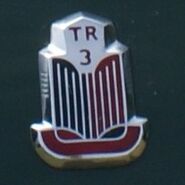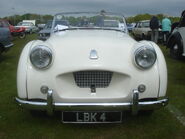The Triumph TR3 is a sports car which was produced between 1955 and 1962 by Standard-Triumph in the United Kingdom. The facelifted variant, unofficially known as the "TR3A", entered production in 1957 and the final version, unofficially the "TR3B", was produced in 1962.

Triumph TR3
TR3[]
Although the car was usually supplied as an open two-seater, an occasional rear seat and bolt-on steel hard top were available as extras.
The car was powered by a 1991 cc straight-4 OHV engine which initially produced 95 bhp (71 kW; 96 PS) increasing to 100 bhp at 5000 rpm. The four speed manual transmission could be supplemented by an overdrive unit on the top three ratios electrically operated and controlled by a switch on the dash. In 1956 the front brakes were changed from drums to discs, the TR3 thus becoming the first British series production car to be so fitted.
13,377 examples of the original "pre-facelift" TR3 were produced, of which 1286 were sold within the UK; the rest were exported mainly to the USA. As of Q1 2011 there were approximately 826 licensed and 115 SORN TR3/3a's registered with the DVLA.
"TR3A"[]
In 1957 the TR3 was updated with various changes including a full width radiator grille and this facelifted model is now commonly referred to as the Triumph "TR3A". However the cars were not badged as such and the "TR3A" name was not used officially, as is evident from contemporary sales brochures. The "TR3A" was built between 1957 and 1962.
The "TR3A" was a minor update from the TR3. The updates included the new wide front grill, exterior door handles, lockable boot handle and came with a full tool kit as standard (this was an option on the TR3). The total production run of the "TR3A" was 58,236. This makes it the third best selling TR after the TR6 and TR7. It is estimated that only 9,500 of the original 58,000 built survive in the world today.
The Triumph TR3 was the first production car to include standard disc brakes, which were continued on the "TR3A" facelift. The car was known for its superior braking ability, making it an autocross favourite.
The "TR3A" is often seen in Vintage and Production racing today. The "TR3A", despite being almost 50 years old, is still competitive in the E-Production class of SCCA (Sports Car Club of America).
In June 1977, Road & Track magazine published an article titled "Driving Impressions: TR3A & TR250" in its 30th anniversary issue. It published a 0-60 mph time of 12.0 seconds, power output of 100 bhp (75 kW) at 4800 rpm, observed curb weight of 2,090 lb (950 kg) and fuel consumption of 28 miles per imperial gallon (10 L/100 km; 23 mpg-US).
"TR3B"[]
The "Triumph TR3B" is an unofficial name given to the final version of the TR3, which was produced by the Triumph Motor Company (Standard Motor Company) in 1962. It was offered concurrent with the TR4, which started production in 1961. In fact, the "TR3B" was a special short production run produced in response to dealer concerns that the buying public might not welcome the TR4.
It had the body of the "TR3A" (Except that the body panels had raised stampings under the hood & trunk hinges and under the door handles. In addition, the wind screen was attached with bolts rather than the Dzus connectors used on "A" models.), but the 2,138 cc. engine and all synchromesh transmission of the TR4. The engine is a straight 4, push rod, 3 bearing, with wet liners. It had 9:1 compression and was very rigid. It was fitted with two H6 SU carburetors. It had 105 hp (78 kW) at 4,650 rpm and 172 N·m (127 ft·lbf) of torque at 3,350 rpm. It got around 20 miles per US gallon (12 L/100 km; 24 mpg-imp) to 30 miles per US gallon (7.8 L/100 km; 36 mpg-imp). The top speed was limited to about 110 mph (177 km/h). by the gear ratio, unless it had overdrive. Electrically triggered overdrive (Laycock-de-Normanville Type A) was available as an option and operated on 2nd, 3rd, and 4th gears. Appearance was identical to the "TR3A", and as such very similar to the TR3, except for a wider grill and door handles.
The suspension was by double A-arms, manganese bronze trunnion, coil springs and tube shocks at the front, optional anti-roll bar, and with worm and peg steering. Unlike MGs of the same period, the steering mechanism and linkage had considerable play and friction, which increased with wear.
The rear was conventional leaf springs, with solid axle and lever shocks, except that the (box) frame rails were slung under the axle (underslung*). The wheels were 15 inch diameter x 4.5" width (increased from 4" after the first few TR2s), with 48 spoke wire wheels optional. Wire wheels were usually painted, either body color or argent (silver), but matte chrome and bright chrome were also available. It had front disk brakes (the TR was the first production car to feature these as standard equipment) and rear drums with no power assist.
It weighed 2,137 lb (969 kg) which was significantly more than the Morgan +4 and the "Bath Tub" (pre-911) Porsches, but not much more than the MGA and MGB. All except the Morgan, which shared the same engine, were substantially less powerful.
Though, under most conditions it was very responsive and forgiving, it had a some handling vices. The chassis, which it shared with the TR2, TR3, TR3A and TR4 had limited wheel travel, and the car was somewhat tall and narrow for a high performance sports car. As a result, on very hard cornering, the inside rear wheel would lift, causing sudden over-steer due to the increased load on the outside rear tire. This was particularly true with increasingly common radial tires. The original TR2/3/3A suspension was built with older, bias ply tire designs in mind.
The "TR3B" is a true roadster, designed for sunny weather with removable rain protection. It has a convertible top (hood) that snaps on and off and removable side curtains, allowing very low doors with padding to rest one's arm on. There are holes in the floor, with rubber plugs, so that the originally-supplied jack might be used from inside the car, as did the Jaguar XK 120. The optional heater was poor and the shut-off valve was under the hood (bonnet). A third person could get behind the seats, if absolutely necessary.
Gallery[]
| Triumph vehicles | |
|---|---|
| Classic production cars
|
|
| Classic racecars
|
|
| Classic concept cars
|
|










